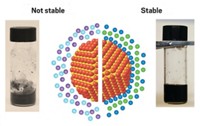Advertisement
Grab your lab coat. Let's get started
Welcome!
Welcome!
Create an account below to get 6 C&EN articles per month, receive newsletters and more - all free.
It seems this is your first time logging in online. Please enter the following information to continue.
As an ACS member you automatically get access to this site. All we need is few more details to create your reading experience.
Not you? Sign in with a different account.
Not you? Sign in with a different account.
ERROR 1
ERROR 1
ERROR 2
ERROR 2
ERROR 2
ERROR 2
ERROR 2
Password and Confirm password must match.
If you have an ACS member number, please enter it here so we can link this account to your membership. (optional)
ERROR 2
ACS values your privacy. By submitting your information, you are gaining access to C&EN and subscribing to our weekly newsletter. We use the information you provide to make your reading experience better, and we will never sell your data to third party members.
Physical Chemistry
Hydrated Electrons Probed Experimentally
Determining fundamental properties of electrons in aqueous solution could provide the key to understanding their role in breaking bonds
by Jyllian N. Kemsley
March 8, 2010
| A version of this story appeared in
Volume 88, Issue 10
Electrons in aqueous solution, also known as hydrated electrons, can be formed by ionizing radiation in cells and are of interest for their role in free-radical formation and DNA damage. Now, five decades after their original discovery, researchers have finally found a way to determine fundamental properties of such electrons, reports a group led by Bernd Abel of Leipzig University, in Germany (Nat. Chem., DOI: 10.1038/nchem.580). The researchers generated solutions with solvated electrons by using an ultraviolet laser pulse and then studied the solutions using ultrafast liquid-jet photoelectron spectroscopy. They found that the energy to eject a hydrated electron from bulk liquid water into a vacuum, or the electron’s vertical binding energy (VBE), is 3.3 eV. The VBE of an electron at a water surface is 1.6 eV. Both values are similar to those estimated from studies of water cluster anions. The researchers hypothesize that solvated electrons at interfaces, such as hydrophilic-hydrophobic regions of cells or proteins, may be key to understanding the role of the species in breaking chemical bonds.




Join the conversation
Contact the reporter
Submit a Letter to the Editor for publication
Engage with us on Twitter